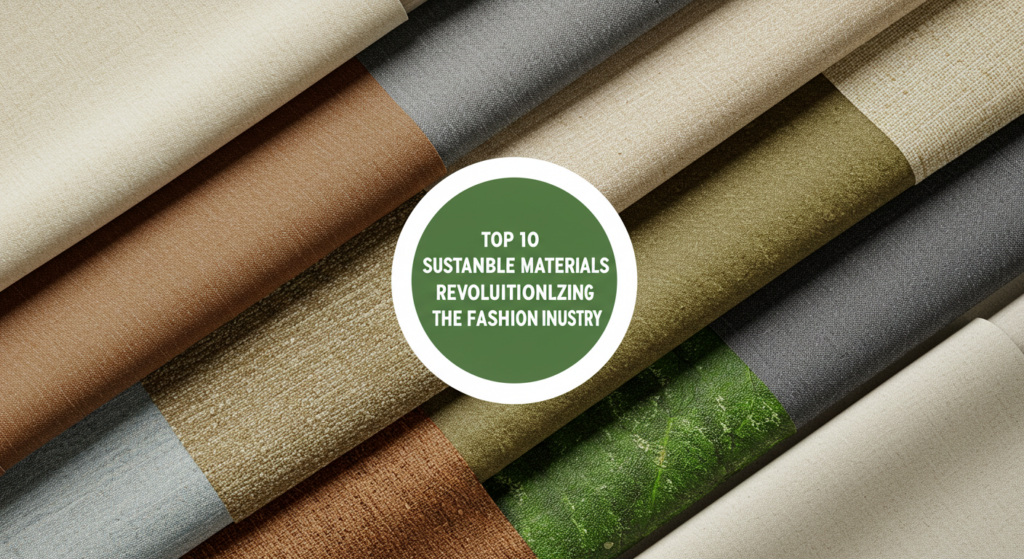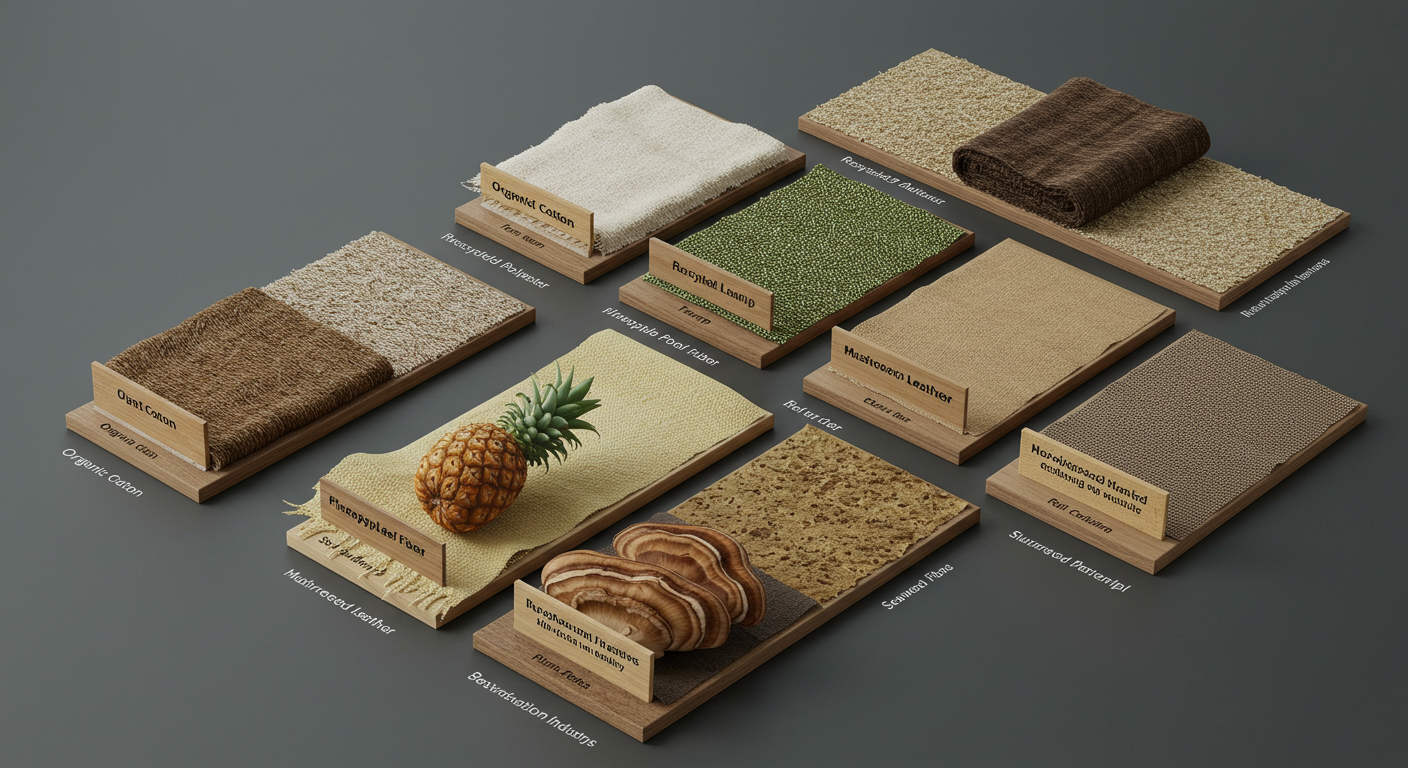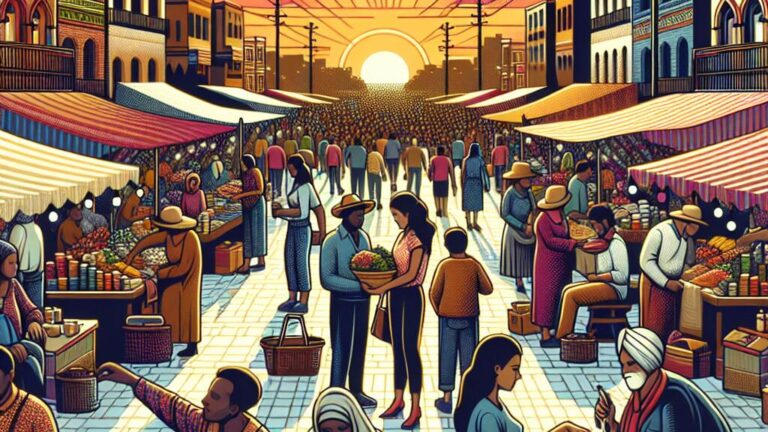Top 10 Sustainable Materials Revolutionizing the Fashion Industry
Sustainable fashion has emerged as a critical response to the overwhelming environmental impact of the fashion industry. With increasing awareness of the pollution in the fashion industry, consumers are seeking alternatives that align with their values. This shift has led to the rise of eco-conscious consumerism and a fashion revolution centered around sustainability in fashion. Brands are now focusing on the Top 10 Sustainable Materials Revolutionizing the Fashion Industry to create stylish yet environmentally friendly options. These materials play a significant role in shaping fashion trends while reducing the industry’s ecological footprint. Embracing sustainable clothing not only addresses the environmental impact of fashion but also fosters a more responsible approach to consumption.
- Sustainable fashion prioritizes ethical production processes.
- It promotes the use of eco-friendly materials to minimize waste.
- Brands are increasingly adopting transparency in their supply chains.
- Consumers are encouraged to choose quality over quantity.
- Recycling and upcycling are fundamental practices in sustainable fashion.
- Supporting local artisans and fair trade initiatives enhances sustainability.
- Educating consumers about the impacts of fast fashion is essential for change.

Importance of Sustainability in the Fashion Industry
The clothing industry has long been criticized for its environmental impact, largely due to the fast fashion model. This approach floods the market with inexpensive garments, leading to waste and pollution. Embracing sustainable products and practices is crucial for shifting this paradigm. Fashion accessories and apparel made from the Top 10 Sustainable Materials Revolutionizing the Fashion Industry not only offer eco-friendly alternatives but also appeal to a growing consumer base seeking to enhance their fashion sense responsibly.
Sustainability in fashion goes beyond just the materials used. It encompasses a comprehensive approach where brands must consider the entire lifecycle of their products, from production to disposal. The textile industry has witnessed innovative shifts as designers and fashion models advocate for responsible sourcing and production methods. By incorporating sustainable materials, companies can reduce their ecological footprint while simultaneously satisfying the increasing demand for ethical consumption among consumers.
Rise of Eco-Conscious Consumerism
The growing demand for sustainable practices in the apparel industry reflects a significant shift towards eco-conscious consumerism. Shoppers increasingly seek out brands that prioritize sustainability, pushing companies to adopt innovative textile technologies and recycled fabrics. This movement emphasizes the importance of sustainable business models, prompting manufacturers to explore the Top 10 Sustainable Materials Revolutionizing the Fashion Industry. As consumers become more aware of the environmental impact of their choices, the pressure on brands to use eco-friendly textile materials continues to rise.
Fabrics made from renewable resources are gaining spotlight due to their minimal environmental footprint. Consumers are drawn to products crafted from alternatives such as organic cotton and hemp, which not only provide comfort but also promote sustainability. The narrative around sustainable fabrics is being supported by brands that incorporate recycled materials into their designs, aligning with a broader commitment to a circular economy. This eco-conscious wave demonstrates that vital progress can be made within the apparel industry through mindful selections of building material and an emphasis on ethical practices.
Top 10 Sustainable Materials Revolutionizing the Fashion Industry
The fashion industry faces significant challenges due to fast fashion’s detrimental impact on the environment. This shift towards sustainability drives a demand for innovative solutions that prioritize sustainable development. The Top 10 Sustainable Materials Revolutionizing the Fashion Industry highlight the critical role of recycled materials and natural fibers in creating greener fashion alternatives. Manufacturers are increasingly turning to these textiles to replace traditional synthetic fabrics, reducing waste and promoting responsible sourcing. By incorporating sustainable materials such as organic cotton, hemp, and Piñatex, brands not only contribute to a healthier planet but also set a precedent for future innovations in building materials and fashion.
Overview of the Top 10 Sustainable Materials
The Top 10 Sustainable Materials Revolutionizing the Fashion Industry play a crucial role in promoting sustainable consumption and reducing the environmental impact of garment factories. As consumers become increasingly aware of their choices, the shift towards slow fashion highlights the importance of materials that contribute to a sustainable future. These materials not only enhance the durability and quality of textiles but also align with the values of luxury brands aiming to minimize waste.
Examining the packaging industry alongside the beauty industry reveals that the principles of sustainability extend beyond clothing. Innovative materials are now being adopted not just in fashion but across various sectors. The industrial revolution has paved the way for these advancements, allowing designers and brands to explore eco-friendly options. Embracing the Top 10 Sustainable Materials Revolutionizing the Fashion Industry can significantly reduce the carbon footprint associated with traditional manufacturing methods.
Criteria for Evaluating Sustainable Fashion Materials
Evaluating sustainable fashion materials involves examining several key criteria that highlight their impact on the environment and the retail industry. The environmental sustainability of a material is paramount, ensuring that resources are sourced responsibly and do not contribute to pollution or waste. For instance, the emergence of synthetic materials like recycled polyester illustrates how recycling technology can transform waste into fashion. This aligns with the growing importance of identifying the top 10 sustainable materials revolutionizing the fashion industry, emphasizing the need for brands to adopt sustainable fashion materials that minimize ecological footprints.
Another significant aspect of these criteria includes the durability and lifecycle of materials used in the sustainable fashion industry. The longevity of a product can reduce its overall environmental impact, supporting sustainable fashion trends that prioritize quality over quantity. Fashion trend forecasting now increasingly incorporates sustainable factors, encouraging designers to innovate with materials like hemp and organic cotton. By focusing on these elements, brands can effectively contribute to the top 10 sustainable materials revolutionizing the fashion industry while attracting eco-conscious consumers eager for responsible choices.
Breakdown of Each Sustainable Material
The exploration of the Top 10 Sustainable Materials Revolutionizing the Fashion Industry reveals a dynamic shift toward eco-friendly alternatives in the sustainable fashion market. Each material brings unique benefits to sustainable fashion production, allowing brands to create innovative and responsible sustainable fashion products. As fashion sustainability trends continue to evolve, sustainable fashion innovations play a crucial role in transforming traditional practices. By integrating these sustainable materials, sustainable fashion brands are not only reducing their environmental impact but also appealing to the growing eco-conscious consumer base in the sustainable fashion world. Understanding these materials is essential for anyone looking to make informed choices in a landscape increasingly defined by sustainable fashion.
Organic Cotton: Benefits and Applications
Organic cotton stands out as one of the Top 10 Sustainable Materials Revolutionizing the Fashion Industry due to its eco-friendly attributes. This natural fiber is grown without harmful pesticides or synthetic fertilizers, making it a leading choice within the sustainable fashion movement. As the modern fashion industry seeks to adopt more sustainable clothing materials, organic cotton offers a viable solution that aligns with the fashion industry needs for reduced environmental impact. Its cultivation supports healthier soil and biodiversity, thus contributing to a more sustainable fashion future.
The versatility of organic cotton allows for various applications within the global fashion industry. From high-quality garments to accessories, its softness and breathability make it a preferred option among consumers prioritizing comfort and sustainability. As fashion technologies evolve, the integration of organic cotton into design processes enhances the sustainable fashion landscape. By choosing organic cotton, brands can demonstrate their commitment to ethical practices, paving the way for a more responsible fashion scene in the years to come.
Tencel: The Biodegradable Alternative
Tencel stands out as one of the Top 10 Sustainable Materials Revolutionizing the Fashion Industry due to its biodegradable properties and eco-friendly production process. Made from sustainably sourced wood pulp, Tencel fibers are produced in a closed-loop system that recycles water and solvents, minimizing waste. As a sustainable material, Tencel is gaining popularity among designers seeking to create innovative fashion products that align with sustainable style principles. This fabric offers a luxurious feel while also being highly breathable and moisture-wicking, making it an excellent choice for various fashion innovations.
The sustainable material use of Tencel in fashion manufacturing not only reduces environmental impact but also caters to the growing demand for sustainable fabrics. Brands are increasingly incorporating Tencel into their collections, reflecting a shift towards eco-conscious consumerism. This versatile material can be found in a wide range of garments, from casual wear to high-end fashion, providing endless possibilities for both designers and consumers committed to sustainable fashion. By embracing Tencel, the industry takes a significant step towards a more sustainable future, reinforcing its place among the Top 10 Sustainable Materials Revolutionizing the Fashion Industry.
| Feature | Description | Benefit |
|---|---|---|
| Biodegradable | Decomposes naturally over time | Reduces landfill waste and environmental impact |
| Sustainably Sourced | Made from responsibly harvested wood pulp | Supports forestry conservation efforts |
| Closed-Loop Production | Recovering and recycling solvents and water | Minimizes resource waste and pollution |
| Comfortable and Breathable | Luxurious feel, moisture-wicking properties | Enhances wearer comfort in various climates |
| Versatile in Fashion | Used in a range of garments from casual to high-end | Appeals to a broad spectrum of eco-conscious consumers |
Recycled Polyester: Transforming Waste into Fashion
Recycled polyester is leading the charge in the Top 10 Sustainable Materials Revolutionizing the Fashion Industry. By repurposing plastic bottles and other waste materials, this innovative fabric reduces reliance on virgin resources while addressing the concerns of the fast fashion industry. Fashion companies that focus on sustainable apparel are increasingly incorporating recycled polyester into their collections. This shift supports the ethical fashion industry, which prioritizes ecological impact alongside style. High-end fashion items made from this material prove that sustainability and luxury can coexist.
The integration of sustainable textile technologies has transformed how the fashion sector approaches material sourcing. Recycled polyester is now a preferred choice among many fashion companies looking to enhance their environmental credentials. By utilizing it, brands contribute to reducing plastic waste in landfills and oceans. This effort aligns with the broader movement towards ethical fashion materials that appeal to eco-conscious consumers. As the fashion world continues to evolve, recycled polyester stands out as a prime example of how innovation can drive change in the industry.
Hemp: The Versatile Eco-Friendly Fibers
Hemp stands out among the Top 10 Sustainable Materials Revolutionizing the Fashion Industry due to its numerous sustainable fabric properties. This versatile plant requires minimal water and no harmful pesticides, making it an eco-friendly choice for sustainable fabric makers. Many fashion brands are beginning to incorporate hemp into their collections, recognizing its durability and ability to biodegrade, thus reducing waste associated with traditional textiles. Fashion organizations are also promoting hemp as part of a sustainable wardrobe initiative, encouraging consumers to make eco-conscious choices.
The appeal of hemp extends beyond its ecological benefits. Many eco-friendly fashion brands utilize this material for its strength, making it suitable for varied applications, from casual wear to high-end fashion. Fashion production using hemp not only supports sustainable practices but also contributes to local economies where hemp is cultivated. As part of the Top 10 Sustainable Materials Revolutionizing the Fashion Industry, hemp continues to be a significant player in the shift towards more responsible fashion choices.
Linen: Sustainable Production Process
Linen stands out among the Top 10 Sustainable Materials Revolutionizing the Fashion Industry due to its eco-friendly production process. Derived from the flax plant, linen requires less water and pesticides than many other crops, making it a prime example of sustainable textile production. This innovative material is not only biodegradable but also boasts durability and breathability, making it an ideal choice for various fashion items. Luxury fashion brands are increasingly incorporating linen into their collections, emphasizing both style and environmental responsibility.
The shift towards sustainable manufacturing methods has led to a greater interest in linen as a staple in both everyday and luxury fashion items. Unlike traditional fashion production practices, which often involve harmful chemicals and resource depletion, linen production emphasizes natural processes that respect the environment. As sustainable materials matter more to consumers, linen continues to gain traction as a favorite among designers committed to eco-consciousness and ethical fashion practices.
Piñatex: Innovative Leather Alternative from Pineapple Leaves
The emergence of Piñatex as an alternative to traditional leather is a significant development within the Top 10 Sustainable Materials Revolutionizing the Fashion Industry. This innovative material, crafted from pineapple leaf fibers, showcases how the fashion industry accounts for sustainability by reducing waste in agricultural practices. By integrating Piñatex into their collections, fashion brands can enhance their eco-friendly reputation while tapping into a growing fashion trend that emphasizes sustainable innovations.
Prominent fashion platforms and leaders advocate for the adoption of Piñatex, recognizing its potential to transform fashion supply chains. As a standout among the Top 10 Sustainable Materials Revolutionizing the Fashion Industry, Piñatex not only presents a compelling option for eco-conscious consumers but also serves as a hallmark of creativity within the fashion realm. Collaborations with fashion innovation agencies further enhance its visibility, solidifying Piñatex’s position as a leader in eco-friendly materials.
Cork Fabric: Renewable and Durable
Cork fabric stands out as one of the top 10 sustainable materials revolutionizing the fashion industry due to its renewable and durable nature. This innovative textile is derived from the bark of cork oak trees, which can be harvested without harming the tree. Renowned luxury fashion brands and trendy fashion brands are beginning to embrace cork fabric, aligning their collections with resourceful fashion practices. Its lightweight properties and unique texture make it ideal for creating chic accessories and sustainable activewear. The sustainable revolution in the fashion economy is being propelled by such material innovations that marry aesthetics with ecological responsibility.
As cork fabric gains recognition, it has not only become a favorite among consumers seeking responsible fashion but also a strong contender for prestigious material innovation awards. Designers are crafting everything from handbags to footwear using cork, proving its versatility. Cork’s ability to withstand wear and tear ensures longevity, a key principle of sustainable fashion. As more brands incorporate this eco-friendly option into their lines, cork fabric’s role in the top 10 sustainable materials revolutionizing the fashion industry becomes increasingly significant, paving the way for a more sustainable and stylish future.
Recycled Nylon: Reducing Ocean Plastic Waste
Recycled nylon stands out as a key player among the Top 10 Sustainable Materials Revolutionizing the Fashion Industry. This eco-material is derived from discarded fishing nets and other nylon waste, transforming what would otherwise contribute to ocean pollution into stunning fashion items. As renowned luxury fashion brands increasingly embrace recycled nylon, they are showcasing its versatility in creating fashionable garments that align with eco-conscious fashion trends. These innovative fashion choices signal a shift towards a more sustainable manufacturing solution, demonstrating how designer materials can make a positive impact on the environment.
The adoption of recycled nylon highlights a growing commitment to an ethical fashion future. Brands integrating this material into their collections are not just reducing waste; they are also setting new standards in sustainable practices. By championing recycled nylon alongside other eco-materials, the fashion industry is paving the way for a more responsible approach to design. The incorporation of recycled nylon into various fashion garments serves as an inspiring example of how creativity can coexist with environmental stewardship, reinforcing the movement of the Top 10 Sustainable Materials Revolutionizing the Fashion Industry.
Vegan Leather: Sustainable Solutions Beyond Traditional Leather
Vegan leather represents a significant shift from traditional fashion practices, offering an alternative to animal-derived materials. As part of the Top 10 Sustainable Materials Revolutionizing the Fashion Industry, this innovative textile uses various plant-based sources and synthetic components. Such durable material caters to the needs of fashion-forward brands that prioritize eco-consciousness without compromising style. Fashion hats made from vegan leather exemplify how these materials can create trendy, sustainable accessories that appeal to a diverse consumer base.
Fashion refers to the ever-evolving landscape of clothing choices, and vegan leather aligns with this dynamic shift. The integration of industrial materials that are sustainably produced helps to minimize environmental impact while providing versatility. Alongside linen-based fashion products, vegan leather is paving the way for a future where fashion embraces both creativity and responsibility. By making conscious choices, consumers can support this movement and champion brands committed to sustainable practices.
Banana Fiber: A Unique Sustainable Resource
Banana fiber stands out as one of the Top 10 Sustainable Materials Revolutionizing the Fashion Industry due to its unique properties and versatility. This eco-friendly textile is derived from the pseudostems of banana plants, often considered waste in banana cultivation. Designers are now transforming this waste into high-quality textiles that lend themselves well to fashionable clothing. The use of banana fiber encourages brands to adopt ethical fashion practices and embrace sustainable production steps, aligning with the growing demand for green fabrics.
The rise of digital fashion brands has further propelled the interest in banana fiber as a key player in sustainable fashion. By adopting new textiles like banana fiber, these brands provide consumers with chic options that reduce reliance on traditional clothing materials. The integration of banana fiber into collections not only meets the demand for eco-friendly textiles but also showcases the innovation within the Top 10 Sustainable Materials Revolutionizing the Fashion Industry. As more consumers prioritize sustainability, banana fiber emerges as a compelling choice for environmentally conscious fashion.
Sustainable Fashion Innovations
Innovation in sustainable fashion relies heavily on the development and adoption of necessary eco-materials that align with ethical fashion principles. The Top 10 Sustainable Materials Revolutionizing the Fashion Industry include a variety of eco-friendly fabrics designed to minimize environmental impact. These clothing materials are made from eco-friendly materials that often feature recycled fabrics, such as transformative econyl fabric, which repurposes waste into high-quality textiles. As brands explore new fabrics, they are increasingly prioritizing the use of renewable resources. This shift not only supports a sustainable approach but also encourages consumers to embrace eco-friendly practices in their fashion choices.
Role of Technology in Promoting Sustainable Materials
Advancements in technology have played a crucial role in developing the Top 10 Sustainable Materials Revolutionizing the Fashion Industry. The emergence of innovative fabrics has enabled designers to create high-quality fabrics that meet organic textiles standards. This transformation supports the ethical fashion movement, offering alternatives that align with a sustainable approach to fashion. Many fashion startups leverage technology to streamline processes and reduce waste, showcasing a new era of responsible consumption.
The role of fashion product lifecycle management (PLM) systems has significantly influenced how brands adopt sustainable business models. These technological tools help track materials from sourcing to production, ensuring compliance with sustainability criteria. As a result, wearable fabrics made from recycled and organic materials are becoming more accessible to consumers. This shift not only benefits the environment but also encourages a more informed shopping experience, driving interest in the Top 10 Sustainable Materials Revolutionizing the Fashion Industry.
| Sustainable Material | Source | Key Feature | Impact on Fashion |
|---|---|---|---|
| Bamboo Fabric | Bamboo plants | Biodegradable & antimicrobial | Reduces chemical usage in textiles |
| Recycled Polyester | Plastic bottles | Reduces landfill waste | Promotes circular fashion concepts |
| Organic Cotton | Cotton plants | Grown without harmful pesticides | Supports farmers’ health and ecosystems |
| Hemp Fabric | Hemp plants | Durable & low impact on resources | Encourages sustainable farming practices |
| Lyocell (Tencel) | Wood pulp | Closed-loop production process | Minimizes water and air pollution |
Impact of Digital Fashion Sustainability
The fashion industry is witnessing a transformation driven by digital solutions that enhance sustainability. Garment manufacturers are now incorporating innovative recycling technology to repurpose materials, ultimately reducing waste. This shift aligns with sustainable initiatives focused on replacing traditional fast fashion models, allowing the introduction of new materials that exemplify eco-friendliness. The emphasis on the Top 10 Sustainable Materials Revolutionizing the Fashion Industry has become central to brand identities, enabling the production of trendy clothing items without compromising environmental integrity.
Digital platforms have also played a crucial role in promoting awareness around sustainable materials. As consumers become more educated about the global organic textile movement, brands are compelled to adopt best practices in sustainable production. This heightened consumer interest encourages designers to explore the top ten manufacturing methods that prioritize eco-responsibility. Emphasizing a great material approach helps bridge the gap between fashion and sustainability, ensuring that future trends honor the planet while satisfying consumer demand.
Sustainable Clothing Materials in Use
The adoption of sustainable clothing materials is pivotal for creating a greener fashion future. Fashion brands are increasingly transitioning from traditional materials to the Top 10 Sustainable Materials Revolutionizing the Fashion Industry. This shift is driven by the demand for cruelty-free fashion and the need to implement sustainable practices throughout the supply chain. Conscious fashion brands are leading the charge, favoring innovative alternatives over traditional textiles and fabrics. Their commitment not only reduces the sustainable impact of fashion but also fosters a culture of responsibility among consumers, encouraging them to make informed choices about their clothing purchases. The emphasis on sustainable materials represents a collective move towards a more ethical and environmentally friendly approach to fashion.
- Increasing use of organic cotton to minimize pesticide use and water consumption.
- Adoption of recycled polyester to reduce plastic waste and lower the carbon footprint.
- Incorporation of Tencel and Lyocell, which are produced from sustainably sourced wood pulp.
- Use of hemp, known for its minimal environmental impact and durability.
- Growing popularity of innovative fabrics made from pineapple leaves, cork, and other plant-based materials.
- Rise in eco-friendly dyeing techniques that reduce water pollution and chemical usage.
- Support for second-hand and upcycled clothing as a sustainable fashion option.
How Brands Are Adopting Sustainable Materials
Brands are increasingly exploring the Top 10 Sustainable Materials Revolutionizing the Fashion Industry to address the negative impacts of fast fashion. Many companies are shifting away from conventional fabrics and embracing eco-friendly materials like organic cotton, Tencel, and recycled polyester. These new materials not only prioritize recyclability but also appeal to consumers who want to express their unique fashion sense while making more informed fashion purchases. By integrating sustainability aspects into product development, brands are paving the way for a more responsible future in fashion.
As brands adopt recyclable textiles and innovative alternatives, they are working to scale sustainability across their collections. This transition is not only about utilizing eco-friendly materials but also about rethinking the entire production process. By investing in sustainable practices and educating consumers, companies are fostering a deeper appreciation for the environment. This shift encourages fashion enthusiasts to consider the long-term benefits of their purchases, ultimately driving demand for the Top 10 Sustainable Materials Revolutionizing the Fashion Industry and signaling a transformative moment in fashion.
Conclusion
The focus on the Top 10 Sustainable Materials Revolutionizing the Fashion Industry signifies a pivotal shift towards eco-consciousness within the sector. Brands increasingly prioritize comfortable fabrics that not only enhance the wearer’s experience but also minimize environmental harm. Conventional textiles, often linked to substantial ecological footprints, are being replaced by innovative alternatives that contribute to sustainability. By embracing these materials, the fashion industry can lead the way in creating a more responsible future, ensuring that style and sustainability go hand in hand.
FAQS
How do innovative textiles help reduce the environmental impact of fast fashion?
Innovative textiles play a crucial role in sustainable fashion by providing alternatives that minimize the environmental impact of fast fashion. Sustainable fashion refers to practices that aim to reduce waste and promote environmentally-friendly materials. By utilizing fabrics with sustainable properties, fashion brands heightens their commitment to eco-friendliness, moving away from traditional fabrics and embracing new, sustainable options. Additionally, a fashion innovation agency can assist brands in incorporating these materials effectively, ultimately fostering a more sustainable future for the industry.
What are the key sustainable fabrics properties driving the shift towards sustainable fashion in the industry?
Sustainable fashion isn’t just a trend; it represents a shift in the industry towards eco-friendly practices. The role of fashion PLM (Product Lifecycle Management) is crucial as it helps brands track and analyze sustainable fabrics properties, enabling them to make informed choices that minimize environmental impact.
What is the role of fashion PLM in promoting sustainable materials within the industry?
The role of fashion PLM (Product Lifecycle Management) is crucial in promoting sustainable materials by streamlining processes, ensuring transparency, and facilitating collaboration among stakeholders in the fashion industry. By incorporating sustainable practices and materials into PLM systems, brands can better track resources, optimize supply chains, and make informed decisions that enhance the environmental sustainability of their products.
How does the role of fashion PLM influence the adoption of sustainable materials in the fashion industry?
The role of fashion PLM is crucial in promoting sustainable materials within the industry, as it facilitates collaboration, improves supply chain transparency, and enhances product development processes that prioritize environmental well-being.
What is the significance of the role of fashion PLM in enhancing sustainability practices in the fashion industry?
The role of fashion PLM is crucial for integrating sustainable practices across the supply chain, enabling designers and manufacturers to access and utilize sustainable materials effectively, ultimately promoting eco-friendly solutions in the industry.
How can the role of fashion PLM be enhanced to further promote the adoption of sustainable materials in the industry?
The role of fashion PLM is crucial in enhancing sustainability practices, as it facilitates better collaboration across teams, streamlines the development process, and ensures that sustainable materials are prioritized in product design, ultimately fostering a stronger commitment to environmentally responsible practices within the fashion industry.
What strategies can brands implement to maximize the role of fashion PLM in accelerating the use of sustainable materials?
Brands can enhance the role of fashion PLM by integrating sustainability metrics into their design processes, fostering collaboration between teams, and utilizing data analytics to track the impact of sustainable materials. This ensures that the role of fashion PLM effectively drives innovation and efficiency in sourcing sustainable materials within the industry.
How does the role of fashion PLM contribute to the overall sustainability goals of the fashion industry?
The role of fashion PLM is crucial in aligning product lifecycle management processes with sustainability goals. By facilitating efficient collaboration and communication among stakeholders, fashion PLM helps brands integrate sustainable practices into their supply chains, ultimately enhancing the role fashion PLM plays in driving environmentally friendly innovations and practices within the fashion industry.







